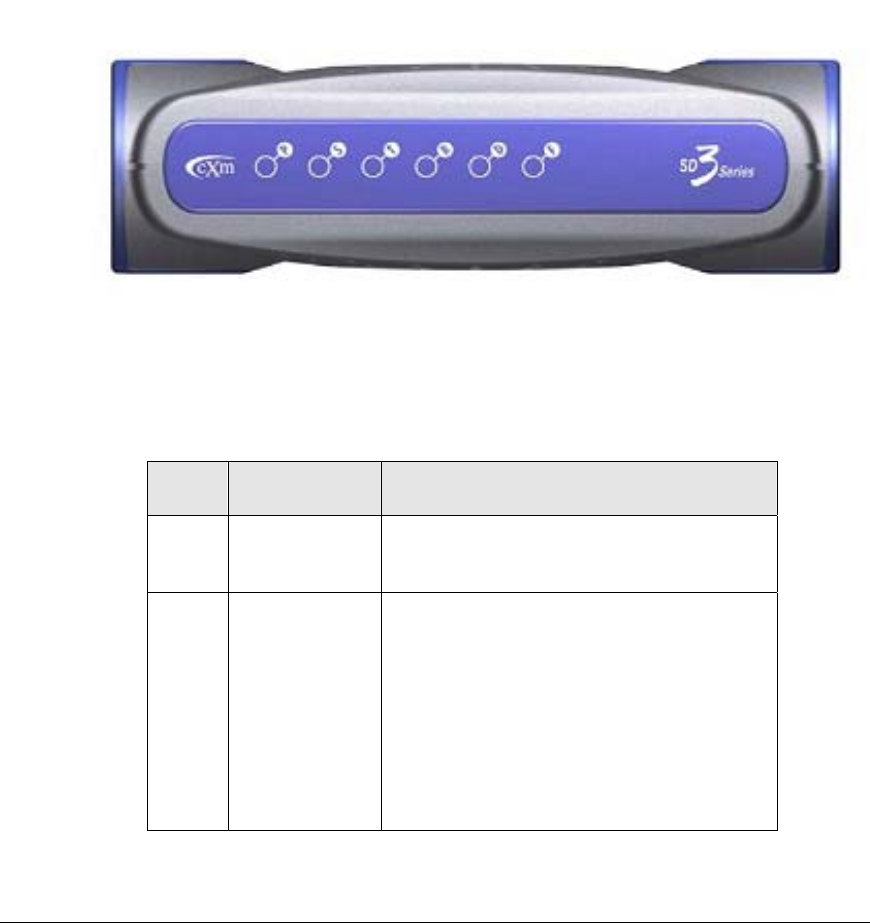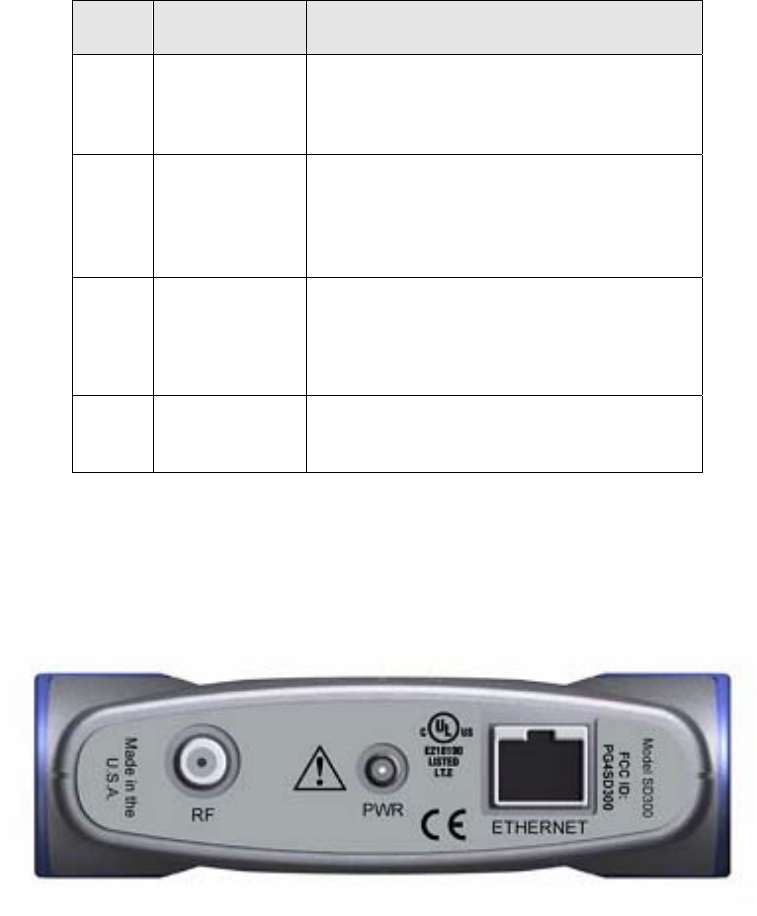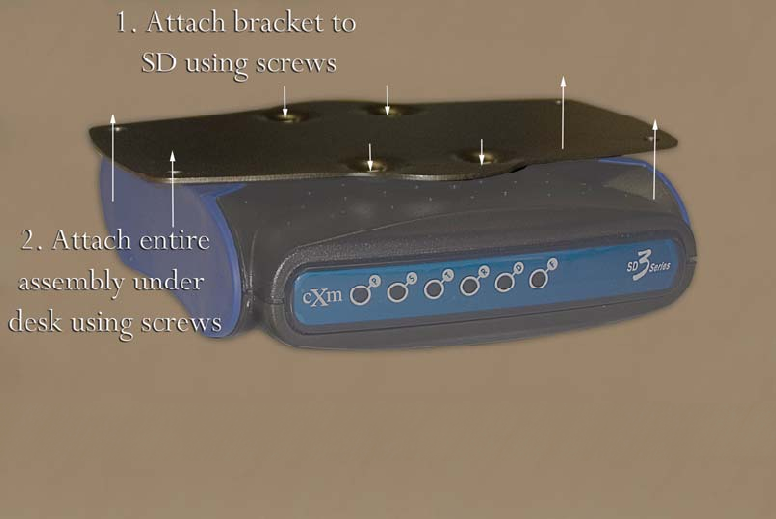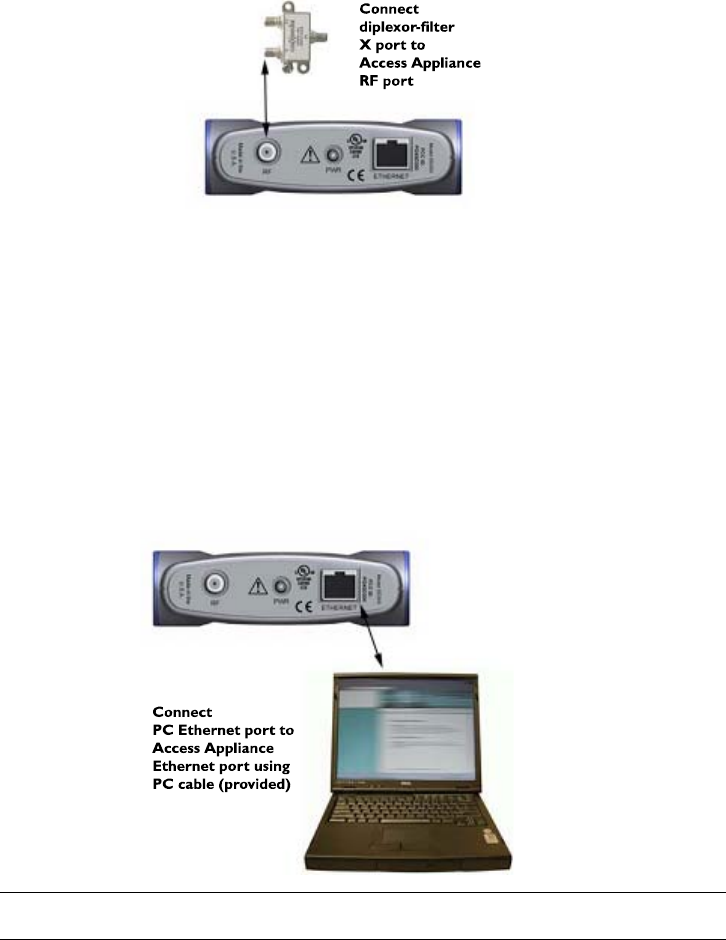ARRIS SD300 Cable Modem User Manual 15B DoC App C Users Guide
Arris International, Inc. Cable Modem 15B DoC App C Users Guide
ARRIS >
Contents
- 1. Users Guide
- 2. User Manual
User Manual

Model: SD300 Report No: 06-0357-15C-PC
FCC Part 15 Subpart B
May 21, 2007 Advanced Compliance Solutions Appendix C
ACS Report: 06-0357-15C-PC
Revision A
Manufacturer: Arris Group, Inc.
Model: SD300
Appendix C: User’s Manual/Installation Guide

Document P/N: 601013-001
CXM
TM
SD300/301 Access Appliance
User Guide
Revision C
February 2006
ARRIS International, Inc.
3871 Lakefield Drive
Suwanee, GA 30024
Warning
This product may not be exported outside the United States and Canada without
authorization from the U.S. Department of Commerce, Bureau of Export Administration.
Any export or re-export by the purchaser, directly or indirectly, in contravention of U.S.
Export Administration Regulation is prohibited.
This document, the hardware, and software is the property of ARRIS International. It
contains information that is confidential and proprietary to ARRIS International. You
may not reproduce, transcribe, or translate in any form by any means, electronic or
mechanical, any part of this publication without written permission.
© Copyright 2000-2006 ARRIS International, Inc. All rights reserved.
Disclaimer
While every attempt to be complete and accurate has been made, this manual may
contain information that is in error. Specifications contained herein are subject to change
without notice. ARRIS International shall not be liable to the purchaser or third party
users for any liability, loss, or damage caused, or alleged to be caused, directly or
indirectly by the use of this publication.
Limited Warranty
ARRIS guarantees that every SD3-Series Access Appliance will be free from physical
defects in material and workmanship under normal use for one (1) year from the date of
purchase. If the product is determined to be defective during the warranty period, please
call ARRIS’s or your equipment provider’s Customer Support to obtain a Returned
Material Authorization (RMA) number. The RMA number should be clearly marked on
the outside of the package, when it is shipped. If returned product is determined to be
functioning properly, a nominal processing fee may be charged to cover shipping and
handling.
This product contains no end-user serviceable parts; authorized technicians should
perform all service.
IN NO EVENT WILL ARRIS BE LIABLE FOR ANY DIRECT, INDIRECT,
CONSEQUENTIAL, INCIDENTAL, SPECIAL OR EXEMPLARY DAMAGES
ARISING OUT OF THE USE, INABILITY TO USE, OR PERFORMANCE OF THE
ARRIS PRODUCT (S), ITS ACCOMPANYING SOFTWARE, OR
DOCUMENTATION,
INCLUDING WITHOUT LIMITATION DAMAGES FOR LOSS OF BUSINESS
PROFITS OR BUSINESS INTERRUPTION, BASED UPON PRINCIPLES OF
CONTRACT, WARRANTY, NEGLIGENCE, STRICT LIABILITY OR OTHER TORT,
BREACH OF ANY STATUTORY DUTY, PRINCIPLES OF INDEMNITY OR
CONTRIBUTION, EVEN IF ARRIS HAS BEEN ADVISED OF THE POSSIBILITY
OF SUCH DAMAGES.
Furthermore, ARRIS makes no warranty or representation (expressed, implied, or
statutory) with respect to its products, accompanying software, or documentation, or to
their use, as well as disclaims against their quality, performance, merchantability, or
fitness for any particular purpose. Therein, ARRIS does not warranty that the products
will be error-free or will operate without interruption.
ARRIS reserves the right to revise or update its products, software, or documentation
without obligation to notify any individual or entity.
FCC Compliance
This device complies with Part 15 of the FCC Rules. Operation is subject to the following
two conditions: (1) this device may not cause harmful interference, and (2) this device
must accept any interference received, including interference that may cause undesired
operation.
Note: This equipment has been tested and found to comply with the limits for a Class B
personal computer and peripherals, pursuant to Part 15 of the FCC Rules. These limits are
designed to provide reasonable protection against harmful interference in a residential
installation. This equipment generates, uses, and can radiate radio frequency energy, and,
if not installed and used in accordance with the instructions, might cause harmful
interference to radio communications. However, there is no guarantee that interference
will not occur in a particular installation. If this unit does cause harmful interference to
radio or television reception, which can be determined by turning the unit off and on, the
user is encouraged to try to correct the interference by one of more of the following
measures:
• Reorient or relocate the receiving antenna.
• Increase the separation between the equipment and the receiver. Connect the
equipment into an outlet on a circuit different from that to which the receiver
is connected.
• Consult the dealer or experienced radio/TV technician for help.
Warning: FCC Regulations state that any unauthorized changes or modifications to this
equipment not expressly approved by the manufacturer could void the user's
authorization to operate this equipment.
Canadian Compliance
This Class B digital apparatus complies with Canadian ICES-003.
Cet appareil numérique de classe B est conforme à la norme Canadienne NMB
003.
NEC Compliance
The SD300/301 Access Appliance is intended for connection to a cable system, which
has been properly grounded in accordance with the National Electric Code.
UL Compliance
To insure proper operation and UL compliance of the SD300/301 Access Appliance in
the USA, use only an ARRIS-approved power supply.
-- Blank Page --

SD300/SD301 Access Appliance
Table of Contents i
Table of Contents
1: Overview........................................................................................................................ 3
Introduction.................................................................................................................. 3
Target Audience........................................................................................................... 3
Package Contents......................................................................................................... 3
Items You Need ........................................................................................................... 4
Personal Computer Requirements ............................................................................... 4
Building Requirements ................................................................................................ 4
Operating Safely .......................................................................................................... 4
Servicing the Access Appliance .................................................................................. 6
Customer Care ............................................................................................................. 7
2. Installing the Access Appliance ................................................................................... 9
About the Access Appliance........................................................................................ 9
Front Panel.............................................................................................................. 9
Rear Panel ............................................................................................................. 10
Before Installing ........................................................................................................ 11
Select a Location........................................................................................................ 11
Connecting the Access Appliance ............................................................................. 12
3. Configuring Your PC ................................................................................................. 17
Configuring Windows 98 .......................................................................................... 17
Configuring Windows 2000 and ME......................................................................... 18
Configuring Windows XP ......................................................................................... 18
4. Using Your Access Appliance .................................................................................... 19
Accessing the Internet................................................................................................ 19
Troubleshooting Connection Problems ..................................................................... 19
Appendix A: Specifications............................................................................................ 21
Client Interface .......................................................................................................... 21
Electrical Specifications ............................................................................................ 21
Environmental Specifications.................................................................................... 21
Physical Specifications .............................................................................................. 21
Appendix B: Optional Equipment and Replacement Parts........................................ 23
Index................................................................................................................................. 25

SD300/301 Access Appliance

SD300/SD301 Access Appliance
Table of Contents 3
1: Overview
Introduction
ARRIS welcomes you to the world of Broadband. Through the use of our SD300/301
Access Appliance and your PC, you can take advantage of the many Internet services
available today, and will be ready with high-speed connectivity that will be required for
the services of tomorrow. ARRIS has alleviated the typical concerns of installing new
computer equipment, making installation as easy as setting up a VCR. And once it’s set
up, using the product is as simple as double-clicking an icon.
The SD300/301 Access Appliance includes these features:
• Provides access to Broadband services
• Easy to install and use
• Doesn’t require opening the PC or changing existing network settings
• Uses a unique geometric design with clearly-marked status indicators
• Multiple units can operate in a single building or within a single dwelling
• Operates over existing cable TV or CATV wiring without interfering with
reception or other services in any way
• Uses patented transmission techniques specifically designed to overcome
topology issues commonly found in the on-premises cable distributions
networks of Multi-Dwelling Units (MDUs) and hotels.
Target Audience
The SD300/301 Access Appliance was designed with the general computer user in mind,
to insure fast, easy installation and operation.
Package Contents
Check the SD300/301 Access Appliance package. In addition to this User’s Guide (on a
CD), the package should contain:
Chapter 1: Overview
• one Access Appliance
• one Ethernet PC cable
• two coaxial cables (one 2-foot and one 8-foot)
• one Diplex-Filter or splitter (depending on SD model)
• one power adapter with attached power cord
If you are missing any items, contact the service provider from whom you received the
Access Appliance.
Items You Need
In addition to the Access Appliance package, you need the following items:
• one Personal Computer - see requirements below
• 1 7/16” or adjustable wrench (optional) — might be needed to loosen and
tighten cable connections.
• one CATV wall outlet
Personal Computer Requirements
The Personal Computer (PC) must meet the following requirements:
• Have an available Ethernet communications port.
• Have Microsoft Internet Explorer 4.0 or later, or Netscape Navigator 4.0 or
later.
Building Requirements
This unit operates only in buildings using ARRIS Internet Access Solutions.
Operating Safely
The Access Appliance has been engineered with both performance and safety in mind.
However, safety is also your responsibility. Read and observe all these recommended
safety precautions.

Chapter 1: Overview
ARRIS SD300/301 Access Appliance User Guide Page 5
Important Rules for Safe Operation
Check power
sources Plug this device only into the recommended
power source indicated on the product’s marking
label. If you are not sure what type of power
source is provided at your location, consult your
local power company or other certified expert.
The U.S. is 110Vac
Japan is 100Vac
Europe is 230Vac
Australia is 264Vac
Always use
the provided
power adapter
Always use the power adapter provided with the
product. Do not use any substitutes. If the
provided adapter becomes damaged or
misplaced, see the Replacement Parts chapter.
Be careful of
overloading Do not overload wall outlets or extension cords,
as this can result in the risk of fire or electric
shock. Don’t use any frayed power cords. Don’t
stretch cords to reach the appliance or other
devices; tension at the connectors is a fire hazard.
Avoid damage
to power
cords
Arrange power supply cords so they are out of the
way. Route them through areas where it is
unlikely they will be walked on or objects rolled
over them.
Avoid placing
the product
near any heat
source
Never place this product near any heat source.
This includes any kitchen appliances (ovens,
toasters, etc.), heating vents, or any other heat
source. This is a fire hazard.
Do not use the
product near
water
Never use this product anywhere near a water
source or in a damp area. Don’t use it near
bathroom or kitchen water sources such as sinks
or washing appliances. Don’t use it near pools.
Don’t use it in a damp area such as a basement.
Avoid
stacking Avoid stacking this item on top of or under other
devices that can generate or radiate heat. Such
stacking can concentrate heat sources in a small
area and creates a fire hazard.
Use caution
when moving
the product
Use caution whenever moving the Access
Appliance. If dropped, resulting damage could
render the appliance inoperable or a fire hazard.

Chapter 1: Overview
Important Rules for Safe Operation
Ground the
cable system Be sure the outside cable system is grounded to
provide some protection against voltage surges
and built-up static charges. Section 810 of the
National Electric Code, ANSI/NFPA No. 70-1984
(section 54 of the Canadian Electrical Code, Part
1) provides information with respect to proper
grounding of the cable system. Always refer to
local building codes to ensure compliance with all
applicable grounding requirements.
Do not
connect or
disconnect
the RF coax
cable
Do not connect or disconnect the RF coax cable
to or from your Access Appliance while the
Appliance is plugged into the power source.
Unplug the
power adaptor
before
cleaning the
Access
Appliance
Do not use liquid cleaner or any aerosol cleaner.
Use only a damp cloth for cleaning.
Protect from
lightning For added protection for this product during a
lightning storm, unplug all devices from the
coaxial cable and power sources when they are
not in use, especially for any extended time.
Take care
when
disconnecting
and re-
connecting a
power source
Wait at least 10 seconds after disconnecting the
power adaptor before re-connecting it.
Servicing the Access Appliance
Caution: Do not remove covers from or attempt to service the product yourself.
Opening or removing covers may expose you to dangerous voltage or other hazards and
void the product warranty. Refer servicing of this product to qualified service personnel
under the following circumstances:
• When the power supply or cord is damaged.
Chapter 1: Overview
ARRIS SD300/301 Access Appliance User Guide Page 7
• If liquid has been spilled onto or objects have fallen onto the product.
• If the product has been exposed to rain or water.
• If the product does not operate normally by following the operating
instructions.
• If the product had been dropped or its enclosure has been damaged.
• When the product exhibits a distinct change in performance, such as the
inability to perform basic functions, indicating a need for service.
Customer Care
If after reading through this documentation you still have questions regarding the use of
the Access Appliance, please contact ARRIS Customer Care:
Web: cxm-support@arrisi.com
Phone: 678-473-8240
Monday-Friday, 9:00am to 5:00pm Eastern Standard Time
Chapter 1: Overview

Table of Contents 9
2. Installing the Access Appliance
The chapter provides step-by-step instructions for installing your Access Appliance. The
SD300/301 Access Appliance is easy to install; taking an average of 15 minutes to set up.
However, before getting started, it is important for you to read the following information.
About the Access Appliance
Front Panel
The LED indicators on the front of the Access Appliance indicate the current operational
status.
LED Description Operation
P Power On when power is being provided by the
power adapter.
S Sync Off when the Access Appliance is not
receiving a service signal from the central
access equipment.
Blinks when the Access Appliance has
not been activated by the central access
equipment.
On steadily when the Access Appliance
has been recognized by the central
access equipment.

Chapter 2: Installing the Access Appliance
Page 10 ARRIS SD300/301 Access Appliance User Guide
LED Description Operation
T Transmit Data On when data is ready to be transmitted.
(Might blink fast when sending streams of
data.)
R Receive Data On when the Access Appliance is waiting
for the PC to read data.
(Might blink fast when receiving streams
of data.)
D Disable On when the Access Appliance is disabled,
preventing access to the Internet.
On when maintenance or diagnostics is being
performed by the central access equipment.
F Fault Blinks randomly if a fault is detected by
the Access Appliance.
Rear Panel
The ports at the back of the Access Appliance connect the appliance to your computer,
power, and the coax network.
Note: When making these connections, unplug the TV/VCR, computer, and the
SD300/301 from the power source, as a precaution.

Chapter 2: Installing the Access Appliance
ARRIS SD300/301 Access Appliance User Guide Page 11
LED Description Operation
RF Coax
Connector Used for connecting the Appliance to
the coaxial network via the coaxial
cable.
PWR Power Used to provide power to the unit.
Ethernet Ethernet Port Used to connect the Access
Appliance to the PC for Ethernet
operation.
Before Installing
1. Review the Personal Computer Requirements on page 3.
2. Review the Building Requirements on page 4.
3. Review the Safety Information on page 4.
4. Gather tools. Although most installations do not require any special tools, it might be
necessary to use a 7/16” wrench or pliers to loosen an existing coax cable
connection on a TV or CATV wall outlet. ARRIS recommends that you lightly tighten
all coax cable connections associated with installing the Access Appliance to ensure
solid, reliable connections; this can be done with a wrench, with pliers, or by hand.
Installation Considerations
Select a Location
The next step in installing your new Access Appliance is selecting a CATV outlet that is
located near your computer. When making your selection, consider where you use your
PC/laptop and the distance between that location and the CATV outlet. Although coaxial
cables are provided with your Access Appliance, they might not be long enough for your
installation. If this is the case, you must purchase RG-6 or RG-59 cables with F-type
connectors. The cables included with the Access Appliance are two feet and eight feet
long.
Access Appliance Mounting
If the Access Appliance is being installed in a location requiring it to be secured, an
optional mounting kit can be utilized (Model# MK300-001); allowing the Access
Appliance to be mounting on a wall, under a desk, or behind an amore. However, keep

Chapter 2: Installing the Access Appliance
Page 12 ARRIS SD300/301 Access Appliance User Guide
in mind the consideration noted above and insure the unit is place such that the LEDs and
MAC address label are visible. Also insure that the Access Appliance connections are
accessible.
The figure below demonstrates how to affix the mounting bracket to the Access
Appliance.
Connecting the Access Appliance
The following illustration diagrams the series of steps involved in connecting the parts
together. Many parts have labeled connectors; those labels are in bold type.
Caution: As a precaution , turn off power to the computer and TV (or VCR) before
connecting the cables. ARRIS recommends that you disconnect them from the wall
power outlets.
Note: To ensure proper operation and UL compliance of product in the USA, use only an
ARRIS-approved power supply.
Follow these steps to set up your Access Appliance:
1. Disconnect the TV from the CATV Outlet.
Locate the cable connecting your TV (or VCR) to the wall cable TV/CATV outlet.
Unscrew the end from the wall connector. Leave the other end connected to the
TV/VCR. If you aren’t using a TV in the room, skip this step.

Chapter 2: Installing the Access Appliance
ARRIS SD300/301 Access Appliance User Guide Page 13
2. Connect the TV to the diplex-filter (or splitter for SD301 models).
Connect the end of the coaxial cable that was unscrewed from the TV/CATV
outlet to TV port of the provided diplex-filter or splitter. If a TV or other device is
not being used, leave the TV port unconnected.
Caution: Do not substitute a generic cable splitter for the provided diplex-filter.
If you are not connecting to a TV in the room, use the provided diplex-filter,
leaving the TV connector unconnected.
If you use one or more cable splitters in the room, you may continue to use
them; however, you must install the diplex-filter so that it is the first device
connected to the TV/CATV outlet.
3. Connect the Diplex-Filter to the CATV Outlet.
a) Locate the shorter (2-foot) coaxial cable included with the Access
Appliance and connect one end to the IN port of the diplex-filter or
splitter.
b) Connect the other end of that coaxial cable to the CATV wall outlet.
4. Connect the Access Appliance to the diplex-filter.
a) Locate the longer (8-foot) coaxial cable included with the Access
Appliance and connect one end to the X port of the diplex-filter or splitter.
b) Connect the other end of that coaxial cable to the RF port of the Access
Appliance.

Chapter 2: Installing the Access Appliance
Page 14 ARRIS SD300/301 Access Appliance User Guide
Note: Make sure are all connections are secure; if necessary, use a wrench or
pliers to lightly tighten the connections.
5. Connect the PC Cable.
a) Locate the Ethernet PC cable included with the Access Appliance and
connect it to the Access Appliance’s Ethernet port.
b) Connect the other end of that cable to an active Ethernet port on your PC. If
your PC does not have an Ethernet port, one must be installed before you
can use the Access Appliance. Many computer retail stores and service
centers can perform this task, if you require assistance.
Caution: Do not attempt to insert the supplied Ethernet cable into a dial-up modem. Doing
so could damage your modem port and/or the Ethernet cable.
6. Connect the Power Adapter to the Appliance.
Locate the included power adapter and connect the appropriate end to the PWR
port on the Access Appliance.

Chapter 2: Installing the Access Appliance
ARRIS SD300/301 Access Appliance User Guide Page 15
7. Apply Power to the Access Appliance.
Plug the transformer cable into the wall power outlet.
Caution: Before plugging the adapter into the power outlet, check the voltage
requirements printed on the power adapter. If the power adapter’s input voltage
specification does not match what is being provided at your AC outlet, contact
your service provider or ARRIS for a replacement. See the chapter on Operating
Safely on page 4.
The P indicator on the Access Appliance front panel should light up when power is
supplied.

Table of Contents 17
3. Configuring Your PC
After all the necessary hardware connections have been made, your computer’s network
configuration might need to be adjusted. Often when using the Ethernet connection,
Internet Service Providers require your Ethernet card to be configured to obtain an IP
address automatically, using Dynamic Host Control Protocol (DHCP). You can find
instructions for making the necessary adjustment below; however, your Internet Service
Provider might supply you with additional instructions that should take precedence.
Please refer to these instructions if supplied.
These procedures apply to the following operating systems:
• Windows 98
• Windows 2000
• Windows Me
• Windows XP
Note: For Unlisted Operating Systems: if you are using a PC with an Apple, Linux, or
any other operating system not mentioned here, refer to your operating system’s
documentation for instructions on how to enable DHCP client operation.
Note: If information is already entered in these fields, be sure to write down all this
information before making any changes. You will need to re-enter this information if you
remove the SD300/301 from your system.
Configuring Windows 98
1. Click Start > Settings > Control Panel.
2. Double-click the Network icon.
3. Double-click TCP/IP. Select the IP Address tab.
4. At the IP Address tab, select the Obtain an IP Address automatically option.
5. Click OK, then OK once more. If the computer prompts you to reboot, do so now.
Chapter 3: Configuring Your PC
Page 18 ARRIS SD300/301 Access Appliance User Guide
Configuring Windows 2000 and ME
Note: Under Windows 2000, you must be logged in using an account with
administrators’ rights to make the necessary changes.
1. Click Start > Settings > Control Panel.
2. Double-click the Network and Dial-Up Connections icon.
3. Right-click the Local Area Connection icon and select Properties.
4. Double-click Internet Protocol (TCP/IP).
5. At the General tab, select the Obtain an IP Address automatically option.
6. Select the Obtain DNS server address automatically option.
7. Click Apply, then click OK. If the computer prompts you to reboot, do so now.
Configuring Windows XP
1. Click Start > Settings > Control Panel.
2. Click Network and Internet Connections, then Network Connection.
3. Right-click the Local Area Connection icon and select Properties.
4. Double-click Internet Protocol (TCP/IP).
5. At the General tab, select the Obtain an IP Address automatically option.
6. Select the Obtain DNS server address automatically option.
7. Click Apply, then click OK. If the computer prompts you to reboot, do so now.

Table of Contents 19
4. Using Your Access Appliance
Accessing the Internet
Your Access Appliance provides you with an “Always-On” connection to the Internet, so
simply start up your e-mail client, Web browser, newsgroup reader, or other Internet
applications and use them as usual.
If you have any security concerns about leaving your PC connected while it is not in use,
firewall software or equipment can be purchased at many computer retailers; or you can
simply unplug the Ethernet cable from the PC until you need to access the Internet again.
Troubleshooting Connection Problems
The P (Power) and S (Sync) LEDs should be ON; and you should see the T (Transmit)
and R (Receive) LEDs flash when you attempt to browse the Internet.
If the S or F LED is blinking or no LEDs are on, check all the hardware connections and
cables (refer to Connecting the Access Appliance on page 3).
If the P, S, and D LEDs are ON, the Access Appliance is functioning correctly, but it has
not been enabled. Contact your service provider for service activation.
Chapter 4: Using Your Access Appliance
Page 20 ARRIS SD300/301 Access Appliance User Guide

Table of Contents 21
Appendix A: Specifications
Client Interface
• Ethernet transfer speed: up to typical 10/100BaseT speeds
• Cable connectivity: RJ-45 Ethernet
Electrical Specifications
There are two options for the AC Adapter:
• Inputs: 120VAC 50/60 Hz
Operating Ranges: 108-132 VAC
Output: 5VDC, 1A
• Inputs: 240VAC 50/60 Hz
Operating Ranges: 220-240 VAC
Output: 5VDC, 1A
Environmental Specifications
• Operating Temperature: 0 to +40 C
• Storage Temperature: -40 to +75 C
• Humidity: 10% to 90% non-condensing
Physical Specifications
The dimensions are: 4.26”wide, 5.32” deep, 1.24” high.
Appendix A: Specifications
Page 22 ARRIS SD300/301 Access Appliance User Guide

Table of Contents 23
Appendix B:
Optional Equipment and Replacement Parts
Many optional and replacement parts are available for the SD300/301 Access Appliance.
If you need to replace or add a part, consult the service provider from whom you obtained
this product.
The following appliance options and replacements are available. Specify the part
number(s) as well as description(s) of any part when ordering to ensure correct
identification of the item
.
Part Number Description
CB201-001 Ethernet Cable - 10ft
PS200-001 SD20x/30x AC Power Adaptor -
Plug Type: North America (GlobTek 48-5-1000R)
PS200-002 SD20x/30x AC Power Adaptor -
Plug Type: Australia (GlobTek WR37A1000LCP-N
or equivalent)
PS200-003 SD20x/30x AC Power Adaptor -
Plug Type: Europe (GlobTek WR23A1000LCP-N
or equivalent)
PS200-004 SD20x/30x AC Power Adaptor -
Plug Type: UK (GlobTek WR35A1000LCP-N or
equivalent)
PS200-005 SD20x/30x AC Power Adaptor -
Plug Type: Japan (GlobTek WR49A1000LCP-N or
equivalent)
CD300-001 SD3-SERIES Access Appliance User’s Guide CD
Appendix B: Optional Equipment and Replacement Parts
Page 24 ARRIS SD300/301 Access Appliance User Guide

Table of Contents 25
Index
C
Coaxial Cable · 8, 15
L
Location for Installation · 15
P
Personal Computer Requirements · 8
Power Supply · 4
S
Safe Operation · 9
Security Concerns · 21
T
Tools · 15
Troubleshooting · 21
Appendix B: Optional Equipment and Replacement Parts
Page 26 ARRIS SD300/301 Access Appliance User Guide